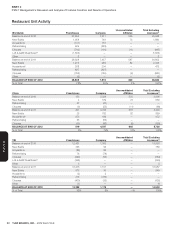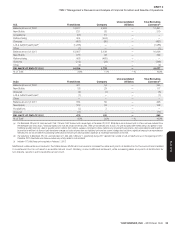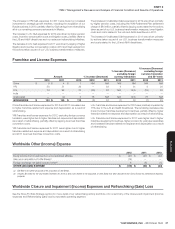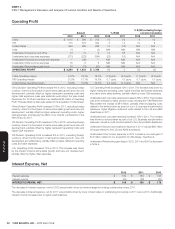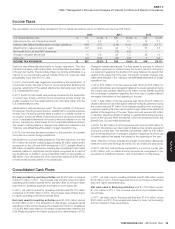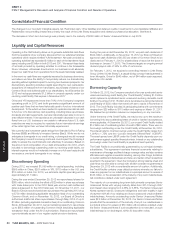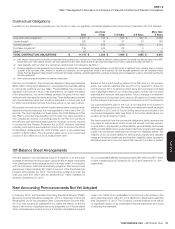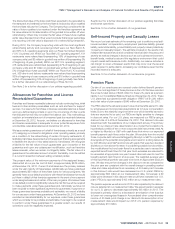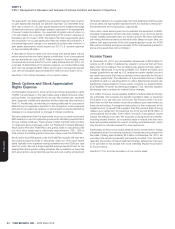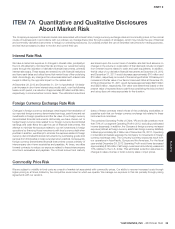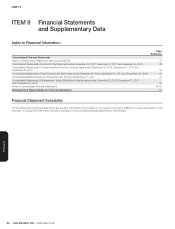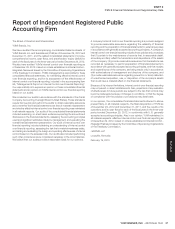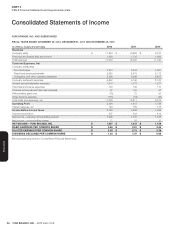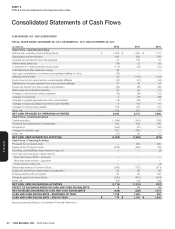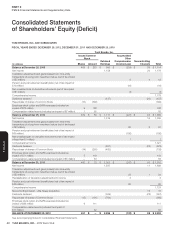Pizza Hut 2012 Annual Report Download - page 124
Download and view the complete annual report
Please find page 124 of the 2012 Pizza Hut annual report below. You can navigate through the pages in the report by either clicking on the pages listed below, or by using the keyword search tool below to find specific information within the annual report.
YUM! BRANDS, INC.-2012 Form10-K 32
Form 10-K
PART II
ITEM7Management’s Discussion and Analysis ofFinancial Condition and Results ofOperations
Critical Accounting Policies and Estimates
Our reported results are impacted by the application of certain accounting
policies that require us to make subjective or complex judgments.These
judgments involve estimations of the effect of matters that are inherently
uncertain and may signifi cantly impact our quarterly or annual results of
operations or fi nancial condition.Changes in the estimates and judgments
could signifi cantly affect our results of operations, fi nancial condition and
cash fl ows in future years.A description of what we consider to be our
most signifi cant critical accounting policies follows.
Impairment or Disposal of Long-Lived Assets
We review long-lived assets of restaurants (primarily PP&E and allocated
intangible assets subject to amortization) semi-annually for impairment, or
whenever events or changes in circumstances indicate that the carrying
amount of a restaurant may not be recoverable.We evaluate recoverability
based on the restaurant’s forecasted undiscounted cash fl ows, which
incorporate our best estimate of sales growth and margin improvement
based upon our plans for the unit and actual results at comparable
restaurants.For restaurant assets that are deemed to not be recoverable,
we write down the impaired restaurant to its estimated fair value.Key
assumptions in the determination of fair value are the future after-tax cash
fl ows of the restaurant, which are reduced by future royalties a franchisee
would pay, and discount rate.The after-tax cash fl ows incorporate
reasonable sales growth and margin improvement assumptions that
would be used by a franchisee in the determination of a purchase price
for the restaurant.Estimates of future cash fl ows are highly subjective
judgments and can be signifi cantly impacted by changes in the business
or economic conditions.
We perform an impairment evaluation at a restaurant group level if it is more
likely than not that we will refranchise restaurants as a group.Expected
net sales proceeds are generally based on actual bids from the buyer, if
available, or anticipated bids given the discounted projected after-tax cash
fl ows, reduced by future royalties a franchisee would pay, for the group
of restaurants.Historically, these anticipated bids have been reasonably
accurate estimations of the proceeds ultimately received. The after-tax
cash fl ows used in determining the anticipated bids incorporate reasonable
assumptions we believe a franchisee would make such as sales growth and
margin improvement as well as expectations as to the useful lives of the
restaurant assets, including a deduction for the anticipated, future royalties
we would receive under a franchise agreement with terms substantially
at market entered into simultaneously with the refranchising transaction.
The discount rate used in the fair value calculations is our estimate of the
required rate of return that a franchisee would expect to receive when
purchasing a similar restaurant or groups of restaurants and the related
long-lived assets.The discount rate incorporates rates of returns for
historical refranchising market transactions and is commensurate with the
risks and uncertainty inherent in the forecasted cash fl ows.
At December29, 2012 we had indefi nite-lived intangible assets of
$440million, $409million of which was attributable to the Little Sheep
trademark we acquired in 2012. We evaluate indefi nite-lived intangible
assets for impairment on an annual basis or more often if an event occurs or
circumstances change that indicates impairment might exist. We may elect
to perform a qualitative assessment to determine whether it is more likely
than not that the fair value of an indefi nite-lived intangible asset is greater
than its carrying value. If a qualitative assessment is not performed, or if
as a result of a qualitative assessment it is not more likely than not that the
fair value of an indefi nite-lived intangible asset exceeds its carrying value,
then the asset’s fair value is compared to its carrying value. Fair value is
an estimate of the price a willing buyer would pay for the intangible asset
and is generally estimated by discounting the expected future after-tax
cash fl ows associated with the intangible asset.We perform our annual
test for impairment of our indefi nite-lived intangible assets at the beginning
of our fourth quarter and no impairment was recorded.
See Note2 for a further discussion of our policies regarding the impairment
or disposal of property, plant and equipment and intangible assets.
Impairment of Goodwill
We evaluate goodwill for impairment on an annual basis or more often if
an event occurs or circumstances change that indicates impairment might
exist.Goodwill is evaluated for impairment by determining whether the fair
value of our reporting units exceed their carrying values. Our reporting units
are our operating segments in the U.S., our YRI business units (which are
aligned based on geography), our India Division and our China Division
brands.We may elect to perform a qualitative assessment for our reporting
units to determine whether it is more likely than not that the fair value of the
reporting unit is greater than its carrying value. If a qualitative assessment
is not performed, or if as a result of a qualitative assessment it is not more
likely than not that the fair value of a reporting unit exceeds its carrying
value, then the reporting unit’s fair value is compared to its carrying value.
Fair value is the price a willing buyer would pay for the reporting unit, and
is generally estimated using discounted expected future after-tax cash
fl ows from company operations and franchise royalties.
Future cash fl ow estimates and the discount rate are the key assumptions
when estimating the fair value of a reporting unit.Future cash fl ows are
based on growth expectations relative to recent historical performance
and incorporate sales growth and margin improvement assumptions that
we believe a buyer would assume when determining a purchase price for
the reporting unit.The sales growth and margin improvement assumptions
that factor into the discounted cash fl ows are highly correlated as cash
fl ow growth can be achieved through various interrelated strategies such
as product pricing and restaurant productivity initiatives. The discount rate
is our estimate of the required rate of return that a third-party buyer would
expect to receive when purchasing a business from us that constitutes
a reporting unit. We believe the discount rate is commensurate with the
risks and uncertainty inherent in the forecasted cash fl ows.
We perform our annual goodwill impairment review as of the beginning of
our fourth quarter. As of that date, our most signifi cant goodwill balance was
attributed to our Little Sheep reporting unit in the amount of $376million.
This goodwill was recorded upon our 2012 acquisition of the Little Sheep
business largely due to the value we expect to generate from applying
YUM’s processes and knowledge in China to expand the Concept. The
fair values of each of our other reporting units were substantially in excess
of their respective carrying values as of the 2012 goodwill impairment
testing date.
When we refranchise restaurants, we include goodwill in the carrying
amount of the restaurants disposed of based on the relative fair values
of the portion of the reporting unit disposed of in the refranchising versus
the portion of the reporting unit that will be retained.The fair value of the
portion of the reporting unit disposed of in a refranchising is determined
by reference to the discounted value of the future cash fl ows expected
to be generated by the restaurant and retained by the franchisee, which
include a deduction for the anticipated, future royalties the franchisee will
pay us associated with the franchise agreement entered into simultaneously
with the refranchising transaction. Appropriate adjustments are made to
the fair value determinations if such franchise agreement is determined
to not be at prevailing market rates.When determining whether such
franchise agreement is at prevailing market rates our primary consideration
is consistency with the terms of our current franchise agreements both
within the country that the restaurants are being refranchised in and
around the world.The Company believes consistency in royalty rates
as a percentage of sales is appropriate as the Company and franchisee
share in the impact of near-term fl uctuations in sales results with the
acknowledgment that over the long-term the royalty rate represents an
appropriate rate for both parties.


